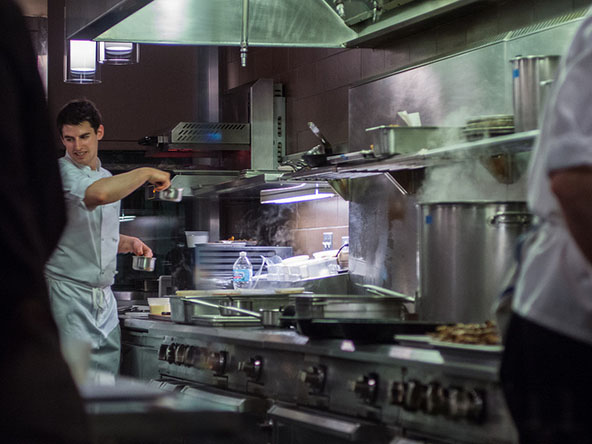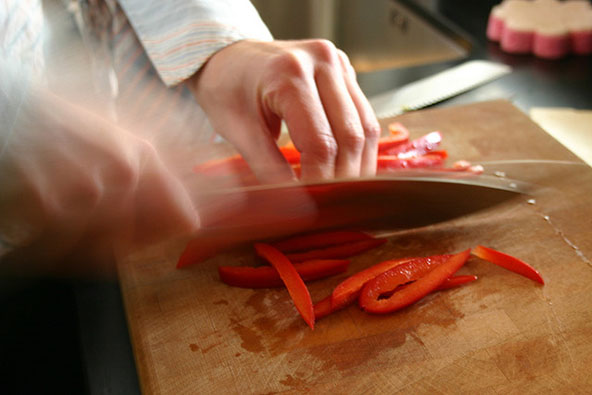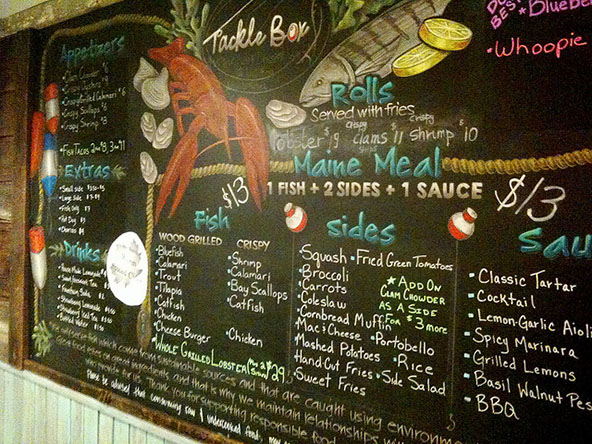Once you get over the shock of not eating stuff like pasta and bread and wine and Holy sh*t! I can't have cereal or yogurt...
Read MoreTips for Eating Paleo in Restaurants
I’ve been eating Whole30-style paleo since 2009, and somewhere along the way, following the guidelines stopped being a massive pain in the butt and just became how I eat. It’s really comfortable and peaceful for me to eat this way when I cook at home.
But ah! There’s the rub.
Even I want to occasionally be a social creature who gets out of the kitchen and leaves the house. Who, perhaps, dresses herself pants designed for yoga or lifting heavy things. Who relishes the opportunity to eat food prepared by someone other than herself. It is at these times that I fire up my Restaurant Detection Skills and brave the world of food cooked outside my kitchen.
My restaurant experiments aren’t always successful. I’ve definitely gotten gluten-bombed when I didn’t expect it, and sometimes in my old neighborhood Tex-Mex place in Austin, I could freak myself out by thinking about the totally cheap-ass eggs they probably serve. But by following a few guidelines and asking lots of questions, I’ve learned how to enjoy eating in restaurants without blowing my good habits or paying too high a price for a planned indulgence.
Disclaimer: I’m not sharing this information because I want you to be paranoid or freaked out about eating in restaurants. One of the questions I get the most from people new to paleo is “How do you eat out?” so I thought I’d share what I know. There are three things to keep in mind as you read this:
1. I eat Whole30 style at home 100% of the time so that when I eat in a restaurant, I don’t have to stress too much about what might be in the food. I almost always avoid gluten, but I sometimes indulge in rice at our local Thai place or shitty, sugary, not-pastured bacon at the diner up the hill.
2. It’s counter-productive to get so stressed out about what you’re eating that you undo the health benefits of eating well. These tips are guidance to make your life easier, not rules to make you feel shame or fear about food.
3. You’re an adult, and the Food Police don’t exist. Eat what you like. You don’t need to explain yourself to anyone or seek approval for your choices. Just be you.
And away we go…
 [photo]
[photo]
Helpful Restaurant Tips
A little preparation and self assertion are all you need to make eating in a restaurant almost as easy as eating at home. Here are some of the tricks I’ve developed so I can enjoy myself in restaurants without worrying about trashing my good habits or feeling deprived.
SCOPE IT OUT
Your delicious restaurant meal starts at home. With a bit of online recon, you can review menus in advance to make sure you can find food that fits into your eating plan. And by deciding in advance what you’ll order, you can prevent temptation from derailing your good intentions.
Even though I sometimes resent the way computers have insinuated themselves into my life, the internet can be extraordinarily helpful when you’re ready to experiment on a new-to-you restaurant. Both chain restaurants and most locally-owned restaurants usually share their menus online, and by being a little bit of a detective on Yelp, you can get valuable insight into the menu and quality of the food.
Your best bets are restaurants that serve meat and produce from nearby farms. The phrase “farm to table” is usually a reliable indicator that the quality of the ingredients will be first rate, and restaurants that concern themselves with serving quality ingredients are also usually good about accommodating “picky eaters.” You don’t have to totally upscale to eat well; neighborhood joints can be a good choice, too.
If I review a menu online and decide what I’m eating before I get to the restaurant, I don’t even look at the menu when I get there. Why make myself feel bad about the fried macaroni-and-cheese balls I can’t won’t eat? If I’m not able to review the menu before I get there, I scan it to find the “not for me” areas — like pasta, sandwiches, etc. — and I just don’t even read them. Key words to look for when scanning a menu: salads, meat, entrées, vegetable sides. The daily specials are also usually a good choice because they’re often made to order, which means you can be super picky about how they’re prepared for you. More on that below…
 [photo]
[photo]
MAKE FRIENDS WITH THE WAITRESS/WAITER
I used to joke that I wanted to be a “raven-haired, tart-tongued detective” and I might sometimes pretend I’m a spy. When I go to a new restaurant, I put those faux detective skills to work. The first task when you arrive at the restaurant is to enlist the server as your partner-in-crime; they can help you understand everything that might end up on your plate. (And this is made easier by the online recon you did to review the menu in advance.)
I’m not gonna lie: It can feel uncomfortable sometimes to ask for what you need, but remember that at the restaurant, you’re paying the tab and you have the right to get exactly what you want on your plate (within reason). Here are some tips and questions to help you team up with your server and get the info you need to make solid choices.
Call ahead: Especially in fine dining or family-owned restaurants, the staff really wants to make your dining experience being a pleasant one. You can almost always call ahead to ask questions and make special requests — espcially now that so many restaurants are at least aware of food allergies and so many diners’ need to be gluten free. Don’t be afraid to ask for what you need; It often makes people feel good to accommodate your needs, especially if it means repeat business.
Ask about gluten: Restaurants have really needed to become more sensitive to the need for gluten-free options for allergies and conditions like Celiac disease. You still have to be alert for gluten-free choices that involve grains and dairy, but a gluten-free menu is a good starting point for asking questions and finding meals that don’t include problem ingredients.
Say “no” to the pre-meal freebies: There is absolutely nothing free about a bread basket, a bowl of peanuts, or basket of tortilla chips. They’re like a devil trying to lure you down a forbidden and dangerous path. When the server attempts to deliver these starters to you with your menu, smile and firmly say “no, thank you.” Keep the baskets off the table for your peace of mind.
Ask about oils: Unless it’s stated otherwise on the menu, most restaurants use canola oil for their griddles, pan frying, deep frying, and salads. If you know you’re sensitive to oils high in Omega-6 fatty acids, avoid deep-fried foods and ask to have your meal cooked in butter or olive oil.
Make substitutions: Changing up the menu is part of the fun! It’s pretty easy to swap side dishes — request a bowl of fruit instead of toast at breakfast, for example — or ask for double orders of good things like vegetables. Yes, you might be charged a little extra on your bill, but it’s worth the investment to get the food your body needs.
Get creative: Play your own game of “You Know How You Could Do That?” Mix and match from the items on the menu to create new combos the chef never considered. Request veggies with sauce instead of pasta, for example, or ask for sandwich fillings on a bed of lettuce instead of between slices of bread. Even a pizza shop should be able to accommodate you with a “salad” made from pizza toppings. All it takes is your imagination and a pleasant request.
Is it homemade? Did you know that the majority of restaurants in the U.S. are serviced by one food supply company for everything from frozen foods to produce and everything in between? That means the salad dressing could be made in a factory and probably includes junk like high-fructose corn syrup, soy, and corn. Ask your server about the ingredients in salad dressings, and if it’s commercially-made, opt instead for vinegar or lemon juice and olive oil for your salad. Ditto for soups, pasta sauces, salsa, and potatoes. Always ask if these things are made in-house.
 [photo]
[photo]
NOBODY IS PERFECT, NOT EVEN THE CHEF
When you cook in your home kitchen, you know exactly what’s going into your meals, and you probably pay equal attention to how good it tastes and how healthy it is. In most restaurants, the numero uno priority is to serve food that tastes awesome. That’s it. “Make it taste good” is usually the chef’s primary driver (followed by, “as economically as possible”). That philosophy means that restaurant chefs add pesky ingredients lik sugars, questionable fats, soy, and wheat to their food in ways that you probably wouldn’t at home.
It’s totally your call on how much “wiggle room” you can accept in restaurant food. During a Whole30, for example, you would say not to brown-sugar crusted ribs at your favorite barbecue joint — but if you’re merely trying to feed yourself as a paleo person, it’s up to you to decide if a little added sugar, a splash of soy sauce, or even canola oil is acceptable to you. For me, I eat Whole30 compliant at home so that when I eat in restaurants, I don’t have to stress about some sneaky sugar, soy, or crappy oils.
However, if you know you have a negative reaction to a certain food — I love corn but 24 hours after eating it, I feel murderous — it should be a no-brainer to avoid that food. Do you grow a painful cannon ball in your stomach after eating cheese or gluten? You probably don’t want to indulge in those foods, even if you want to have a treat. If extra sugar interrupts the quality of your sleep for one night, is it worth it to you? Only you can answer those questions, and your answer might change under different timing and circumstances. The goal is not to be perfect, but to find the guidelines that work for you.
Also, while I’m being a downer. Most restaurants use commercial mayonnaise, even in their homemade salad dressing. Commercial mayo is almost always made from inflammatory, industrial seed oils like canola, safflower, sunflower, or a blend. Avoid restaurant mayo unless you’re choosing it as a “treat.”
 [photo]
[photo]
Paleo-Friendly Cooking Methods
Instinct probably tells you that deep-fried foods aren’t the healthiest choice, but it can be confusing to know what a good cooking method might be. Look for these methods and descriptions to find the most paleo-friendly choices on the menu, and remember to ask your server questions to verify ingredients.
Broiled: Broiled fish, seafood, steak, chicken, and all kinds of chops are a great choice. Be sure to ask if the meat is basted with anything before, during, or after broiling.
Steamed: Steaming is just about the ideal way to cook vegetables. Again, ask if the vegetables are topped with seasoning or fat after cooking. You might need to request that they’re served to you plain (ask for olive oil on the side).
Poached: Fish and chicken poached in water or broth is flavorful, tender, and paleo-approved. Ask the server if wine was included in the poaching broth so you can make an informed decision about whether or not you want to make an exception to your rules for the added flavor.
Braised: This is another great paleo-friendly cooking method that should make you feel confident about the food. There may be wine or soy involved in the braising liquid, so clarify with the server.
Roasted: Roasted meats and vegetables are almost always a good choice; get details about dry rubs or marinades to verify the ingredients.
Grilled: Remember to double-check on marinade and dry rub ingredients — and ask if the grilled meat is finished with a sauce or oil when it comes off the grill. (Our local BBQ place is gluten free except for the BBQ sauce, so I always have to remember to request my meat dry.)
Sous vide: Sous vide is really popular in better restaurants, and it’s a great choice for paleo people. The meat or seafood is cooked in a hot water bath, then finished over or under a high heat source to brown the meat. Again, ask your server if anything is added to the meat when it’s served.
Sautéed: The word “sauté” can go either way. If food is sautéed in a quality form of fat without added sugar, soy, or grains, it gets a green light. If it’s drenched in non-paleo ingredients, it’s a definite stop sign.
Smoked: Like grilling, smoking is a very paleo-friendly cooking method. Sugar is often included in the rubs used on meat, so verify with the server, but the amounts used are usually minimal and not worth worrying about.
Warning: Approach soups and stews with caution. They can be a satisfying one-stop source of quality protein and vegetables, unless the chef thickens them with a flour-based roux or adds cream for a smooth texture. Ask lots of questions about soups and stews, including whether or not they contain soy, flour, grains, or dairy.
Code for “Not Paleo Friendly”
Words like “crispy” and “battered” make food sound very (very, very, very) appetizing, but those words should also sound a warning siren. Anything battered and crispy is most likely rolled in flour and deep-fried in canola oil. Boo.
When you see the following adjectives on the menu, ask lots of questions and be prepared to take a pass on foods that don’t meet your standards.
Deep fried
Crispy
Battered
Coated
Breaded
Sauced
Meatballs/Meatloaf/Croquettes (probably include breadcrumbs)
Sausage
Fritter
Dumpling
 [photo]
[photo]
So… What Are You Gonna Have?
I know. I know! That might seem like a lot of bad news about restaurants, but really, if you’re diligent and ask lots of questions, eating in a restaurant can be no big deal. Remember: you’re not aiming for perfection. Just do your best, then relax and savor your food. Here are some suggestions for good choices in just about any type of restaurant.
AMERICAN RESTAURANTS, DINERS & CAFES
Diners and cafés are probably the easiest restaurants to find paleo-friendly stuff to eat because their menus usually include fresh salads, burgers, and stick-to-your-ribs goodies like roast poultry or meat, steaks, chops, and vegetables. Here are the paleo-friendly options you can usually find on the menu.
Eggs: Scrambled, omelets, poached, fried, or hard-boiled, eggs are a protein-packed choice that can be found just about everywhere. Be sure to ask if the chef includes dairy, wheat, or soy in the scrambled eggs and omelets. Most kitchens will honor your request to make eggs without added ingredients. When in doubt, order poached eggs because the only ingredients are eggs and water.
Bunless burgers: With a salad and a side of vegetables, a burger sans bun makes a great meal. Some restaurants have gotten hip to the trend and offer burgers wrapped in fresh lettuce leaves instead of buns.
Protein and vegetables: When in doubt, a steak and a salad is a pretty safe bet. Other good options are salmon, grilled or roasted chicken, roasted turkey, grilled or broiled pork chops, pot roast, or any variety of fish or seafood. Ask questions about the preparation, request sauces/gravy on the side, and dig in!
Barbecue: Smoked beef, pork, chicken, and turkey are all good choices at your favorite barbecue joint. Although most barbecue rubs contain sugar, it’s a trace amount, so probably not worth too much concern. Beware barbecue sauce, though; it usually includes a lot of sugar as an ingredient and may also pack some soy sauce, too. Order meat dry if you’re really concerned. For side dishes, look for braised greens and tossed salad, but avoid the mayo-based cole slaw and potato salad unless you’re OK with canola oil mayo.
Salads: A big salad is another reliable choice: lots of fresh veggies topped with protein and drizzled with quality fat. Be on the look out for sneaky ingredients like croutons or cheese, and verify the ingredients in the dressing to be sure it complies with your eating standards. This is another place you can get creative by combining toppings from different menu items into your own combos.
Salads can quickly turn from a great choice to a problematic one with the addition of a few unhealthy ingredients. Always request dressings on the side so you can control the amount that’s added to your vegetables, or discretely bring a small container of homemade dressing with you. (What?! Doesn’t everyone carry a plastic container of dressing in their purse?) Don’t forget to ask your server if the salad includes grated cheese and/or croutons and request yours be served without them.
 [photo]
[photo]
INTERNATIONAL CUISINE
You know I love my international food! Here are the things I usually order to eat well and enjoy myself, without feeling deprived or getting a bad food hangover.
Greek/Mediterranean: Grilled fish, Greek salad (minus the feta cheese), gyro meat (as long as it doesn’t contain grains as fillers), roasted chicken, shish kebabs, and olives are all paleo-friendly choices. Take a pass on pita bread, as well as casseroles like moussaka, which will include dairy and flour.
Middle Eastern: Look for beef, lamb, pork, and chicken shawarma, baba ghanoush, and shish kebabs made from lamb, beef, chicken, and vegetables. Tahini dressing — made from lemon juice, sesame seed paste, and olive oil — is a great choice for dipping or drizzling over salads.
Mexican: Focus on meat, salsa, and guacamole. Take a pass on the chip basket and avoid tortillas, gorditas, enchiladas, and other dishes that may be wrapped in tortillas or buried under cheese. In place of rice and beans, request a side of vegetables or grilled jalapeños, if you like it hot. Looks for dishes like steak, shrimp, or chicken fajitas; carnitas; carne asada; barbacoa; and rotisserie-roasted chicken. You can even enjoy tacos, burritos, etc.; just eat the middles and leave the rest (or have the insides piled on a bed of lettuce to make a kickass salad).
Italian: You’re not eating pasta or garlic bread, but that doesn’t mean you can’t enjoy Italian food. Really! Look for roasted chicken, veal piccata, grilled fish, and beef dishes like pot roast. Remember to ask questions about preparation because pan-sautéed meats are often dusted in flour before cooking; your order can probably be made without flour, so ask nicely. A big antipasto platter with olives, peppers, and Italian meats is a good choice, along with side salad dressed with olive oil and vinegar. As a side, order grilled vegetables or a green vegetable, like broccoli or spinach, topped with marinara sauce.
Thai: Thai stir-fries often contain soy, and rice noodle dishes (even though they’re gluten free) can include a lot of added sugar. Go for curries made with coconut milk, protein, and vegetables, instead—and request that the cook double the vegetables in your dish. If you’re sensitive to peanuts, skip the peanut sauce, but you can still enjoy satay; request that green papaya and other salads be made without the chopped peanuts on top.
Indian: Grilled and roasted meats and vegetables — especially tandoori — are usually a safe bet. Avoid curries in rich sauces because they’re based on yogurt and may also include flour. Avert your eyes from the naan.
Japanese & sushi: Sushi restaurants can be a great place to eat paleo with a little preparation and by making special requests. Bring a bottle of coconut aminos with you and use them instead of soy sauce. When ordering maki or hand rolls, ask that they made without rice; sashimi is always an excellent option. Avoid tempura rolls and ask about sauces that might be included in rolls or drizzled over the top, as they most likely include soy and/or sugar. Appetizers like dumplings and edamame are not paleo options, but seaweed salad can be a good choice.
Chinese: Unless you have a relationship with the chef of your local Chinese restaurant, eating Chinese food in a restaurant can be really tough. Most Chinese recipes include soy, cornstarch, rice and rice flour, and added sugars. If you find yourself in a Chinese restaurant and have no other options, the “cleanest” choices are steamed vegetables and roasted meats—like barbecued spareribs or chicken wings—but even those meats will probably include a small amount of soy sauce. If you’re particularly sensitive to gluten and/or soy, you should probably avoid Chinese restaurants and reserve stir-fries for home cooking.
 [photo]
[photo]
A Loving Reminder
Part of the fun of eating out is enjoying foods you don’t usually eat at home — and luxuriating in the experience of someone else doing the cooking and serving. If you stick to your guns when you cook at home 80 to 90 percent of the time, it’s totally OK to loosen up your standards a little to enjoy a restaurant, provided that you don’t knowingly over-do it and hurt yourself.
You are not required to be perfect to be healthy. The paleo guidelines are meant to encourage you to make intentional food choices that help you feel good both physically and emotionally. The tips listed above are meant to help you eat well and enjoy yourself, while respecting your paleo habits. When you decide to indulge in special occasion foods at restaurants or at home, choose only the most delicious options, and savor every single bite.
More Like This...
It occurred to me that new readers might not be familiar with my long, loving track record with the Whole 30. It's not a success...
Read More




If there’s a crappy side with every menu option (like fries) then ask nicely if they do a substitution. Open questions are polite. And the server will probably answer something basically vegetables which is what you want.
I heard some franchise breakfast joints put pancake batter in their omelet batter. Is that true?
Yes, some places do that because it makes the omelets really fluffy.
We went to an IHOP recently and discovered that when making omelets and scrambled eggs, they use eggbeaters. Not sure what all is in that but cannot be good. It may just be our local one, not nationally, don’t know.
IHOP does use an egg substitute as their standard, but you can ask for “shelled eggs” to get real eggs and they don’t charge any extra.
I always ask if the burgers contain bread crumbs or flour. Some restaurants add bread crumbs to burgers, or dust meats with flour to “dry” them before cooking. I also ask if the spice blends contain flour or sugar.
I’ve brought my own salad dressing and mayo to restaurants and gotten weird looks, but I don’t care.
We tend to eat at places that we know are “safe.”
Back in the day (before I found out I was gluten/casein intolerant) one of the highlights of vacations was trying new restaurants and new dishes. Now? Not so much. We tend to bring/cook a lot of our own food.
Excellent tips, thanks for going to the trouble to write it all up!
When I do a Whole30, I ask ALL of the questions, despite being an introvert. As long as you are super nice and as you said, get the server on your side, I’ve never had trouble. And I’ve learned YOU MUST ASK. Once I almost ordered a steak salad but because I asked, I learned that steak was marinated in soy and sugar but the entree steak on the menu was clean.
One other thing worth mentioning – realize you really have to settle for simple food if you’re going to a cheap place. At a nice place, they have all kinds of veggies to offer, olive oil rather than tubs of ‘it’s not butter’ gunk, and a willingness to customize your order. You just can’t expect much from a dive that gets all its food from boxes in the freezer.
This is such a great, thorough post! I love that you remind everyone that you don’t have to be perfect while eating out. I typically try to stay gluten free when I eat out, but by no means do I stress about trying to stay paleo. I eat out so little anyway that I like to make it a treat. Thanks for the post!
I have Celiac disease and follow a Paleo diet and one problem I’ve come across is servers who have no idea what is in the food or exactly how it is prepared. I have learned to ask as many questions as possible and I often ask servers to “check with the chef.” With a smile, of course! Just recently came across your website and am loving it, thanks!
Hah, great timing! I had dinner with a friend at a higher end restaurant today, opting for slow-roasted pork belly. Free substitution of applesauce (byebye sugar) and mashed potatoes (probably has cream/butter in it) for brussels sprouts with bacon bits (probably not fully compliant… but hey!) Eating out for me is such a rare event, and the place has to be pretty darn special, that I don’t overly stress about everything. Then again, I am fortunate in that I eat whole-30 compliant because I want to, and not due to any allergies. Very useful post that I’m bookmarking for an upcoming 5 day trip to Alabama (first time in the States!)
A quick addition– though it’s not always my fave, French food is a good bet for paleo eats. Steak, sauteed veggies, tartare, nicoise salads… usually lots to pick from!
OH AND ALSO CHIPOTLE in a pinch! Carnitas salad (only protein there not cooked in soy bean oil), minus the corn and beans and cheese and dressing, topped with guac and salsa. Maybe everyone already knew that one, though.
This is great! Any thoughts on how to eat at friends’ homes while trying to eat Paleo or Whole30, without destroying your relationships or becoming “that girl”? I definitely have *some* friends who know how I eat and would probably try to be accommodating but do you just generally consider those meals a *treat*? (I eat in a lot of people’s homes because of the nature of my job and this is one of the main things that keeps me from going completely Paleo/Whole30.)
Everyone I now already thinks I’m “that girl” anyway, so i tend to not worry about it too much 😉
Usually, I tell people who are hosting me that I don’t eat any grains or soy and ask if they want me to bring something. That way, they know in advance what I won’t eat, but it also leaves the door open for them to ask for help in preparing the meal. I use the same philosophy eating at someone else’s house as I do at restaurants: it probably won’t be as squeaky clean as if I ate at home, but I’m primarily there for the social aspect, not the food, anyway. Also, meals at others’ houses don’t usually include enough protein, so I just eat supplemental food when I get home.
Thanks! That’s helpful. 🙂
Wow! This is like the definitive guide to eating out! For me anyway 😉 I don’t struggle as much as I used to when eating out, and London seems to be doing pretty well in adapting to people asking for healthier switches in restaurants.
But like you said, at the end of the day if I eat real foods when I’m at home, I don’t have to worry too much on the occasions I’m out.
Love the tip about calling ahead!
Thanks for this!
I just received Well Fed and Well Fed 2 in the mail today as well, and am furiously planning my Sunday cooking. I’ve loved all of the recipes I’ve made so far, and especially love your love of international foods (I share that fondness!).
I’m on Day 5 of Whole30, so far so good. I went to NXNW for dinner last night and they were even nice enough to leave the parmesan out of the sausage stuffed mushrooms and the goat cheese off the bacon wrapped scallops. Success!
I have to ask….so what was your favorite neighborhood mexican joint here in Austin? I’m staying far away from Polvos until this Whole30 is done. 🙂
Thanks again!
Happy Whole30-ing! Glad your NXNW dinner was a success!
When we lived in Austin, our house was down the street from Habanero Cafe on Oltorf. The machacado con huevos is the best there! And their salsa is SO SO SO good.
I just eat tons of sashimi now. Recently got glutened when I ordered a burger on lettuce instead of a bun, and now I’m extra caution. Fortunately my girlfriend is pretty accommodating and most of the places we used to go to before I went paleo have SOMETHING I can eat… I mostly just worry about the gluten when I do eat out now, and keep it clean at home. Soy and cheese and other dairy products don’t bother me, thankfully, so if there is something that sneaks in… such as soy sauce… I won’t get sick the next day, unlike the gluten.
Gotta say it though, the tip about phoning ahead will be a good one when we go on vacation. I wasn’t quite sure how to deal with a bunch of unknown restaurants. All the places we eat know us pretty well, and I used to love the adventure, but now… well…
Great tips!
Still longing for a good curry though. Sigh.
I know it’s been a while since you posted…but if you’re still hurting for curry, I just discovered an AMAZING cookbook called 660 Curries that has allowed me to recreate my absolute favorite chicken saag without having to worry about nasty extras. I do have to sub a few things here and there (coconut cream for dairy, etc.) but they’re all pretty simple, and I can tolerate ghee, so non of it requires rocket science (or even baking science.) Couldn’t believe how authentic and wonderful I could make something taste from my own kitchen. I was always sort of intimidated by Indian cuisine. No more!
Don’t most thai curries contain a ton of added sugar? Seems like they are much sweeter in restaurants than when I make them at home, so I’m usually wary about eating Thai at all.
Yes, Thai restaurants usually add some sugar, but as I said in my intro, eating in a restaurant will never be as clean as eating at home. A coconut curry is the most reasonable choice at a Thai restaurant, given that stir-fries usually include soy and maybe gluten. Your absolute best bet for Thai is to make it yourself, but I like to provide options for people who don’t want to cook every meal at home.
What a great article! Shared it on my blog’s FB profile 🙂 I recently launched a new Paleo blog Getting Primal which actually focuses on travelling while following a Paleo lifestyle…it is still a work in progress (I guess what blog isn’t?) and I am glad to see you publish this article with awesome tips!
Hi Melissa! I am on day 10 of the W30, and have made tons of recipes from your site. I love it. When eating at home, this month isn’t too tough at all! I live in Senegal, West Africa, and I’ll be spending the day in the capital, Dakar, next week. I’m not looking forward to eating out. Customer service is so poor here that I had to chuckle at the thought of asking all the questions on this post. There’s so little awareness about food allergies in this culture. Thankfully, I have a tough gut and am just doing the W30 for fun, so it won’t sabatage my health if I end up eating soy or gluten inadvertently. I’ll try my best, of course, but, like you said, the point is to enjoy the treat with friends or family, right? The best food in Dakar is Lebanese, so I look forward to some tasty meat, veggies, and babaganough. Thanks again for your great recipes and tips! They’ve made my month so far so enjoyable!
Congratulations on Whole30-ing! Just do your best in restaurants :-)… Senegal! I’m envious! Sounds so exotic.
One note about oils in restaurants: The two companies that supply nearly every restaurant in the US both cut their olive oil with soy. That’s right, if you ask for olive oil on your salad at most restaurants, you will be getting dosed with soy. I react very badly to soy, and it took me a long time to figure out what I was doing wrong when eating out (very carefully).
Ew. That is so disappointing. Thanks for sharing!
Thank you very much for providing the guide! I am basically required to be “that girl” as well when eating out. In the last few years I have discovered I am intolerant to lactose, gluten and soy. None of those foods will kill me, but I certainly have a pretty nasty reaction to them. I’ve gotten food bombed a few times when eating out and paid the price…that terrible, painful, “I feel like I’m gonna die – won’t someone please just put me out of my misery…” price. I try to be as careful as possible, but it will certainly help to have a little bit better guide to know where I’m slipping on asking questions.
Thanks for this! I have been eating primal for 2+ years, and have random bouts of 21 days paleo.
I am a Texas girl, and tortilla chips at Mexican food joints is my nemesis! My husband isn’t primal, so I can’t just ask them not to bring them. My will power is week, and lately I have been indulging, but before when I was more strict I would ask them to bring lettuce for me. Sure, I got strange looks, but I had a healthy alternative vehicle to get that delicious salsa in my mouth!
The majority (if not all) of the spare ribs and chicken wings in Chinese restaurants were either cooked or warmed in the deep fryer.
What about eating grass-fed and naturally raised meats at restaurants? Is that possible? If so, where are the best options? Is Halal meat naturally raised in practice?
Grass-fed/pastured, organic meat is always the best choice — and upscale restaurants and even some more affordable places will have high-quality meat. They usually advertise if they do, so look for that. I’m not familiar with the particulars of Halal meat — you’d need to research that on your own.
Thanks so much for these tips! I eat out for lunch a few times a week, and this info is going to help me make the best choices! I find most restaurants have something that is Whole 30/Paleo friendly.
You’re welcome! Just having the reminders makes it easier to make good choices, I think. Happy eating!
For people traveling or eating overseas, fyi, you can download a card to hand to waiters/kitchen indicating you’re gluten-free (and how). I did this in Spain, Portugal, and Morocco and managed to dine well without incident. (Indeed, in Portugal the common meal was grilled fish, a green salad with oil and vinegar at table, and a sort of tomato-less ratatouille with potatoes — which I guess you can now have on paleo or you could pick around.) If you’re traveling, see this link from a Celiac site which has downloadable “gluten free cards” in different languages so you can give them to staff: http://www.celiactravel.com/cards/
Thank you for this great insightful guide. I’m traveling to China for 10 days. No grocery stores, no mini fridge available. And lots of business lunches around a communal table. In the past I’ve avoided mystery meats by saying I’m a vegetarian! Rice is my go to when desperate….now what? Even the vegetables are cooked in corn starch and soy sauce,. my foreign language skills are nonexistent and even when I try , they probably think I’m insulting their ancestors haha. Heeeeeeelp please. Thank you. A
I’m traveling right now… but I’ll think about this in the car and get back to you. It’s a tough one.
I hope I’m not too late to help! Just realized this morning I never got back to you on this.
My philosophy when traveling is this: Eat as much local food as I can to enjoy it without hurting myself. For example, I know that soy, in the short term, is OK for me—but gluten is always a bad idea. My advice for you is to WRITE DOWN what you know about yourself regarding sugar, corn, soy, rice, gluten, etc. then WRITE DOWN your personal guidelines: I can eat rice. I can’t eat gluten. etc. Read through them every day and use them as a guide when ordering. If you’re in a restaurant and get breaded meat, discretely pull the breading off and eat the shrimp or chicken inside. Eat rice so you’re not overly hungry, if it doesn’t cause you physical distress. Look for steamed veggies whenever possible. Eat soup broths and the veggies and protein in them and avoid the noodles—the broth is probably homemade and super nutritious. Use what you know about the Whole30/paleo guidelines to help you make choices, but know you’re probably not going to be able to follow them too strictly, and that’s OK. Enjoy your trip!